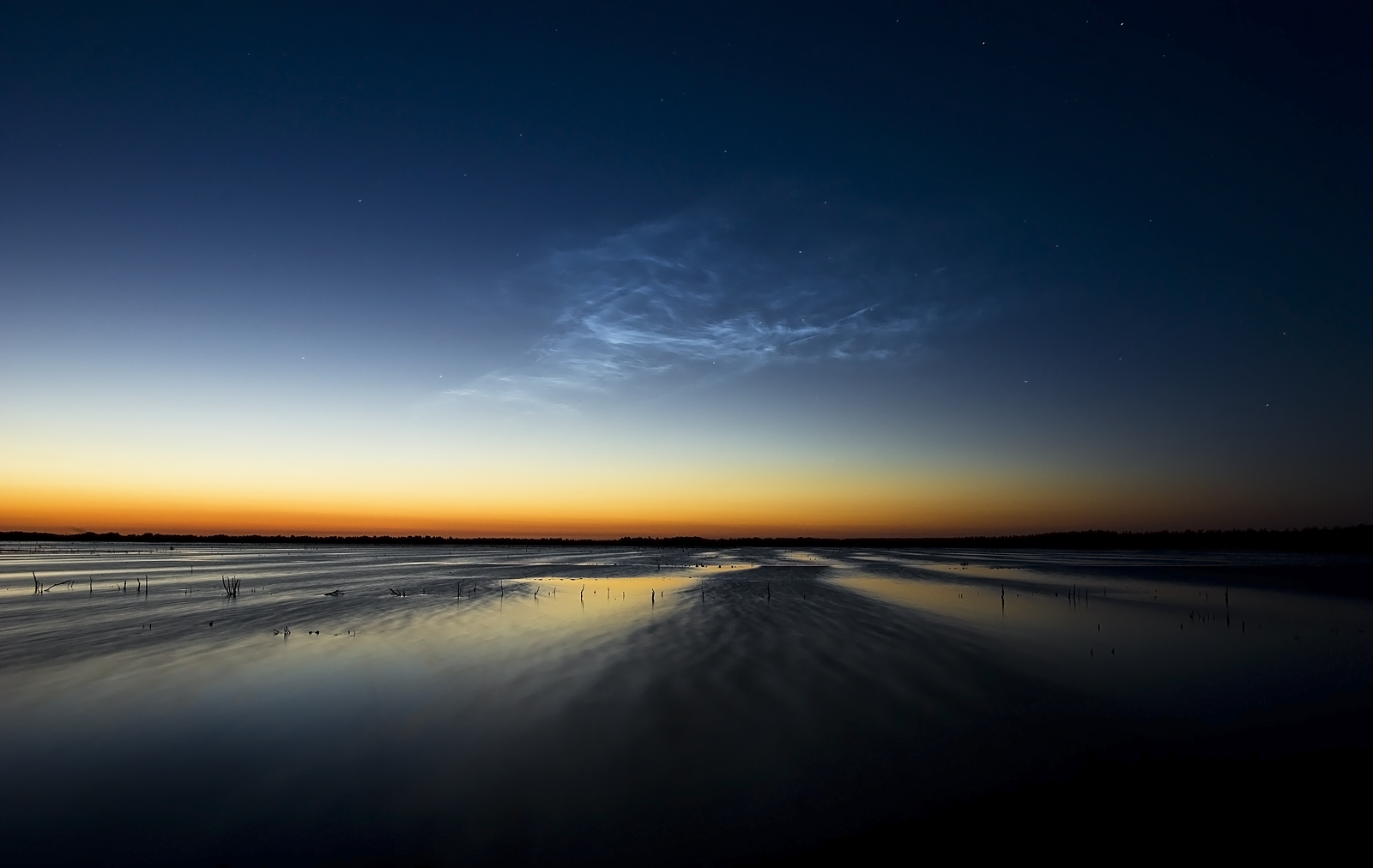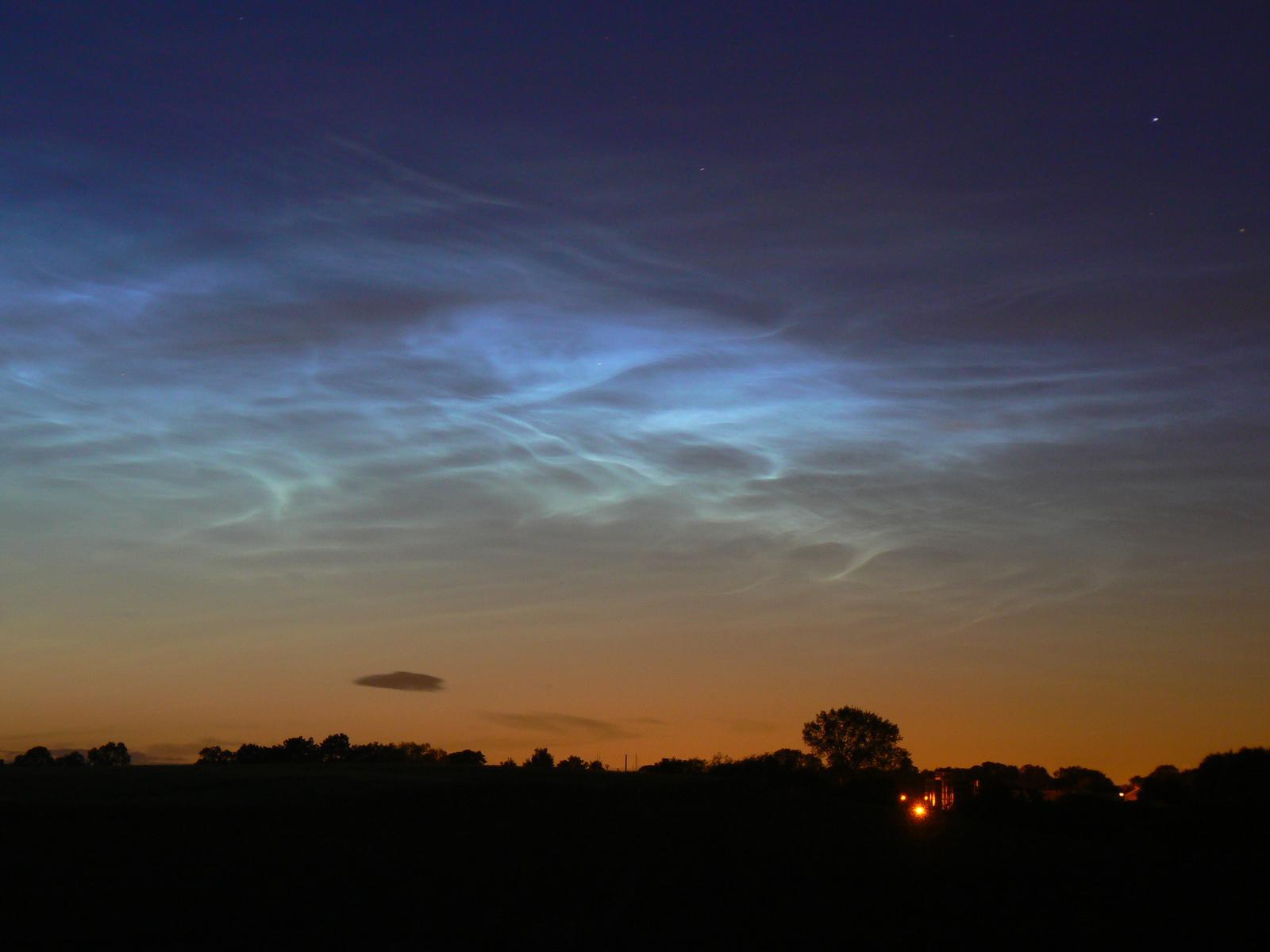.

I saw Eternity the other night: Noctilucent clouds over Bargerveen, Drenthe, The Netherlands: photo by Hrald, 23 June 2009
I saw Eternity the other night,
Like a great Ring of pure and endless light,
............All calm, as it was bright,
And round beneath it, Time in hours, days, years
..................Driv'n by the spheres
Like a vast shadow mov'd, In which the world
............And all her train were hurl'd;
The doting Lover in his queintest strain
..................Did their Complain,
Neer him, his Lute, his fancy, and his flights,
..................Wits sour delights,
With gloves, and knots the silly snares of pleasure
..................Yet his dear Treasure,
All scatter'd lay, while he his eys did pour
..................Upon a flowr.
Like a thick midnight-fog mov'd there so slow,
...........He did nor stay, nor go;
Condemning thoughts (like sad Ecclipses) scowl
..................Upon his soul,
And Clouds of crying witnesses without
...........Pursued him with one shout.
Yet dig'd the Mole, and lest his ways be found
..................Workt under ground,
Where he did clutch his prey, but one did see
..................That policie,
Churches and altars fed him, Perjuries
..................Were gnats and flies,
It rain'd about him bloud and tears, but he
..................Drank them as free.
Sate pining all his life there, did scarce trust
............His own hands with the dust,
Yet would not place one peece above, but lives
..................In feare of theeves.
Thousands there were as frantick as himself,
............And hug'd each one his pelf,
The down-right Epicure plac'd heav'n in sense
..................And scorn'd pretence
While others slipt into a wide Excesse
..................Said little lesse;
The weaker sort slight, triviall wares Inslave
..................Who think them brave,
And poor, despised truth sate Counting by
..................Their victory.
And sing, and weep, soar'd up into the Ring,
............But most would use no wing.
O fool (said I,) thus to prefer dark night
.................Before true light,
To live in grots, and caves, and hate the day
............Because it shews the way,
The way which from this dead and dark abode
.................Leads up to God,
A way where you might tread the Sun, and be
.................More bright than he.
But as I did their madness so discusse,
.................One whisper'd thus,
This ring the Bride-groome did for none provide
.................But for His bride.
Henry Vaughan (1621-1674): The World ("I saw Eternity the other night"), from Silex Scintillans (I), 1650

Noctilucent clouds, Szubin, Poland: photo by Marek Nikodem, 12 July 2009 (via Spaceweather)

Noctilucent clouds above a lake, Bargerveen, Drenthe, The Netherlands: photo by Hrald, 23 June 2009

Noctilucent clouds, UK: photo by Nick Bramhall, 28 June 2007

As to the cause and origin of noctilucent ("night-shining") or polar mesospheric clouds, there are as many theories as there are bewildered computer-modeling geeks.
ReplyDeleteThis NASA researcher thinks it's a methane burp:
Methanogenesis, Mesospheric Clouds and Global Habitability: by Rudolf F. Pueschel, NASA Research Staff
Hyperthermophilic methanogens can exist in a deep hot biosphere up to 110°C, or 6 km deep. Thus, they are part of microbial life, in mass and volume probably comparable with all surface life. This life is widespread at depths in the crust of the earth, just as life has recently been identified in numerous ocean vents and geysers. This life is not dependent on solar energy and photosynthesis for its energy supply, and is essentially independent of surface conditions. The methanogens are capable of obtaining energy for growth by converting carbon dioxide (CO2) and molecular hydrogen (H2) into methane (CH4) and water (H2O). Some methanogenic bacteria are also capable of transforming acetate into CH4 and CO2. This chemical energy scheme inside earth is simpler than photosynthesis on the surface and therefore is more likely to have preceded it, suggesting that life possibly originated deep inside earth.
Geologic (microbial plus abiogenic, thermally stable to 300°C or 300 km depth) CH4 is transported upward, attested to by its association with helium, to contribute to subterrestrial petroleum pools and methane-hydrates beneath the sea floor. Near or at the surface, geologic CH4 mixes with other natural CH4 from wetlands, termites, open ocean, marine sediments and wild fires, and with anthropogenic CH4 from rice paddies, animals, manure, landfills, waste water treatment, biomass burning and coal mining. Some of this CH4 is emitted into the atmosphere at current annual rates of ~500 Tg (teragrams), of which ~ 200 Tg are natural and ~ 300 Tg are man-made. The atmospheric lifetime of CH4, a greenhouse gas 20 times more effective than CO2 in raising global temperatures, is approximately ten years. It is removed from the atmosphere mainly by reactions with the hydroxyl radicals (OH) in the troposphere to form CO2, but also by dry soil and by conversion to H2O in the stratosphere and mesosphere. The current trend in anthropogenic CH4-increase is a contemporary analogue of a "methane burp" some 55 million years ago, when three trillion tons of CH4 out of 15 trillion tons that had formed beneath the sea floor were released into the atmosphere within a few thousand years. The consequence was a greenhouse effect that raised the atmospheric temperatures by 9-12°C which, in turn, allowed modern mammals, the ancestors of horses, cows, deer, apes, and humans, be brought to global dominance. What prevented this CH4-induced greenhouse effect from running away?
[That question have you gripping the edge of your seat, does it?]
ReplyDeleteet seq.:
CH4, in contrast to CO2 and other greenhouse gases, has the unique property of being partly converted to H2O by cosmic radiation in the mesosphere. H2O, in turn, condenses into visible clouds in the presence of cloud nuclei at temperatures that fall below the saturation temperature at given concentrations. Clouds, by virtue of their albedo, prevent sunlight from reaching the lower atmosphere and the earth’s surface and thus lower the global temperature. The current CH4-doubling over the past century resulted in an increase in upper level H2O from 4.3 ppmv to 6 ppmv. This 30% increase in H2O vapor yielded a tenfold increase in brightness of polar mesospheric clouds because of a strong dependence of the ice particle nucleation rate on the water saturation ratios. Models show that at a given temperature the optical depth of mesospheric clouds scales as [H2O]b with b varying between 4 and 8. Radiative transfer tools applied to mesospheric cloud particles suggest that an optical depth of approximately one, or 1000 times the current mesospheric cloud optical depth, would result in tropospheric cooling of about 10°C. Assuming b = 6, a thousandfold increase in optical thickness would require a three-fold increase of H2O, or a 20-fold increase of CH4. At the current rate of anthropogenic emissions this is expected to occur within the next millennium. This timescale is also commensurate with what has been assumed for the CH4-burp 55 million years ago.
But that's just one theory. Another, proposed by a Cal Tech researcher, posits that the PMCs are celestial magnetic vacuum cleaners, sweeping up metal dust from the upper atmosphere:
ReplyDeleteCaltech Scientist Proposes Explanation for Puzzling Property of Night-Shining Clouds at the Edge of Space
An explanation for a strange property of noctilucent clouds -- thin, wispy clouds hovering at the edge of space at 85 km altitude -- has been proposed by an experimental plasma physicist at the California Institute of Technology (Caltech), possibly laying to rest a decades-long mystery.
Noctilucent clouds, also known as night-shining clouds, were first described in 1885, two years after the massive eruption of Krakatoa, a volcanic island in Indonesia, sent up a plume of ash and debris up to 80 km into Earth's atmosphere. The eruption affected global climate and weather for years and may have produced the first noctilucent clouds.
The effects of Krakatoa eventually faded, but the unusual electric blue clouds remain, nestled into a thin layer of Earth's mesosphere, the upper atmosphere region where pressure is 10,000 times less than at sea level. The clouds, which are visible during the deep twilight, are most often observed during the summer months at latitudes from 50 to 70 degrees north and south -- although in recent years they have been seen as far south as Utah and Colorado. Noctilucent clouds are a summertime phenomenon because, curiously, the atmosphere at 85 km altitude is coldest in summer, promoting the formation of the ice grains that make up the clouds.
"The incidence of noctilucent clouds seems to be increasing, perhaps because of global warming," says Paul M. Bellan, a professor of applied physics at Caltech.
Twenty-five years ago, researchers at Poker Flat, Alaska, discovered that the clouds were highly reflective to radar. This unusual property has long puzzled scientists. Bellan, reporting in the August issue of the Journal of Geophysical Research-Atmospheres, now has an explanation: the ice grains in noctilucent clouds are coated with a thin film of metal, made of sodium and iron. The metal film causes radar waves to reflect off ripples in the cloud in a manner analogous to how X-rays reflect from a crystal lattice.
Sodium and iron atoms collect in the upper atmosphere after being blasted off incoming micrometeors. These metal atoms settle into a thin layer of vapor that sits just above the altitude at which noctilucent clouds occur. Astronomers recently have been using the sodium layer to create laser-illuminated artificial guide stars for adaptive optics telescopes that remove the distorting affects of atmospheric turbulence to produce clearer celestial images.
Measurements of the density of sodium and iron atomic vapor layers show that the metal vapor is depleted by over 80 percent when noctilucent clouds are present. "Noctilucent clouds have been shown to act very much like a flycatcher for sodium and iron atoms," Bellan says. Indeed, in laboratory experiments, other researchers have found that at the frigid temperatures (-123 degrees Celsius) within noctilucent clouds, atoms in sodium vapor quickly become deposited on the surface of ice to form a metallic film.
"If you have metal-coated ice grains in noctilucent clouds, the radar reflectivity can become enormous" he says. "This reflectivity is not the sum of reflections from individual ice grains, which would not produce a very large reflection. Instead, what happens is that ripples in the cloud of metal-coated ice grains reflect in unison and reinforce each other, somewhat like an army marching in step across a bridge causes the bridge to vibrate."